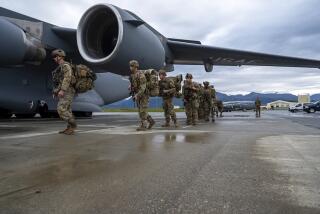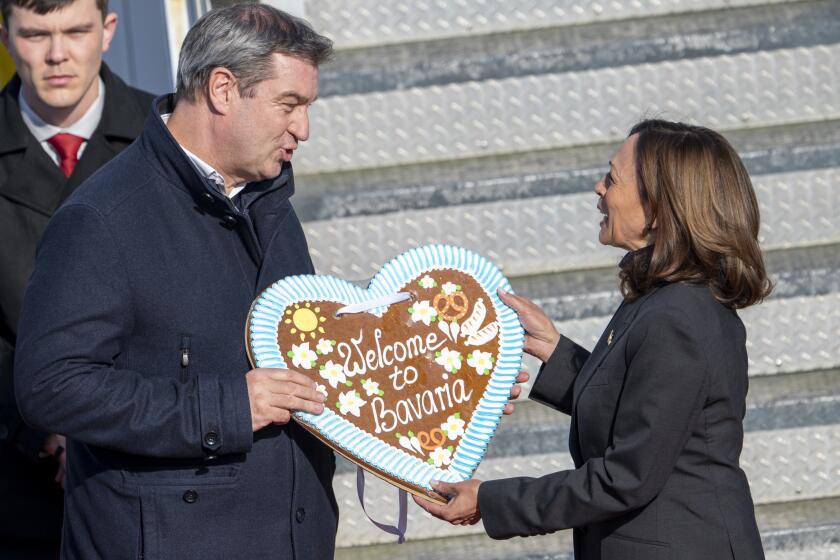Issue of U.S. Ordnance Shadows New Panama Bridge
The opening of the $100-million Centenary Bridge over the Panama Canal next month is expected to reduce traffic bottlenecks and spur residential and commercial development. But it also underscores a thorny issue in U.S.-Panamanian relations: Who is responsible for cleaning up shuttered U.S. military weapons testing ranges in the former Canal Zone and beyond?
Panamanians are eager to begin using the structure, only the second fixed bridge to connect the halves of the country split by the canal, which the United States turned over to Panama in 1999.
But its opening is also likely to stir resentment toward the United States for not having fully cleaned up three Canal Zone weapons testing ranges, one of which abuts an access road to the gleaming new suspension bridge. Many unexploded rounds remain, and officials here worry that unsuspecting motorists who wander off the roadway for a breath of fresh air could get blown up. So could residents of low-income housing units that are expected to be constructed near the new bridge and access roads.
For now, the ranges’ 7,671 acres, or about 2% of the total former Canal Zone area, are officially uninhabitable.
Panama and the U.S. are also at odds over who should remove seven unexploded chemical weapons bombs thought to contain mustard gas that were dropped on an island about 35 miles off Panama’s Pacific coast during and after World War II. Some people here say the bombs could be spirited away and used by terrorist groups.
Whatever the outcome, the dispute highlights the disparity between the U.S. military’s weapons cleanup obligations at abandoned foreign bases as compared with domestic American bases. When an installation in the United States is deactivated, the Pentagon’s responsibility for cleanup, and for any damages and injuries that might result from hazardous materials, is complete and never-ending, according to American law.
But at abandoned foreign bases and weapons ranges, the extent of cleanup is limited, tied to specific language in the treaty covering the closure.
Bombs, mortar rounds and artillery shells were dropped or fired onto the Balboa West, Empire and Pina firing ranges for decades until two years before the canal was turned over in 1999.
The Panamanian government’s position is that the U.S. military should clean up its mess. “We continue to hope the United States will reconsider and come to the table to negotiate,” said an official with Panama’s environmental protection agency who spoke on the condition of anonymity.
The issue is delicate: Calls requesting comment from the offices of President Martin Torrijos and Foreign Minister Samuel Lewis Navarro were not returned. Observers say Torrijos’ government is not keen to criticize the United States at a time when it is negotiating a bilateral free trade agreement with Washington that will require approval by the U.S. Congress.
U.S. Embassy spokesman Will Ostick said the U.S. military adhered to terms of the 1977 treaty covering removal of hazardous materials left in the former Canal Zone and has partially cleaned up exploded ordnance. Further cleanup of the former Canal Zone is not “practicable,” he said, for environmental, safety and cost reasons, which according to the treaty, would relieve the U.S. of further responsibility.
Fully removing the arms would require forest clearing in the former Canal Zone, which in turn would endanger the watershed that supplies the canal and makes the operation of its locks possible, he said. Retrieval of the munitions would also cost lives and “millions, if not billions, of dollars,” sources said.
During a visit to Panama in November, Defense Secretary Donald H. Rumsfeld said the “U.S. apparently has assumed its obligation under the treaty, and the matter has been closed.”
The case involving U.S. chemical weapons testing on Panama’s picturesque San Jose Island, one of the so-called Pearl Islands famed for pearl harvesting during Spanish colonial times, is far more complex.
From 1944 to 1947, the U.S. military conducted top-secret chemical weapons testing on the islands, experimenting with bombs to be used in island jungle warfare against the Japanese. At least seven unexploded bombs were left behind, and in 2002, a team from the Organization for the Prevention of Chemical Weapons in The Hague confirmed that the remaining 1,000- and 500-pounds bombs probably contained deadly mustard gas.
Panama’s government has argued that the United States is liable for removal of the bombs under a 1993 international chemical weapons convention signed by both the United States and Panama. Embassy spokesman Ostick said the United States rejects such an obligation. After years of negotiations, the United States made a “last, best offer” to Panama in 2003 to resolve the matter, he said. The plan called for the U.S. to train and equip a team of Panamanians at a cost of $2 million to find and dispose of all of the chemical weapons on San Jose, an offer Panama “regrettably” refused, Ostick said.
Panama said it refused in part because the deal included a “quit claim” provision, which would have cleared the U.S. from responsibility for any additional bombs found after the team was trained. People familiar with the island believe there are many more bombs to be found.
Among them is George Novey, a Panamanian entrepreneur whose investor group bought the island in 1978 and is developing it for tourism. He recently showed a reporter two of the bombs lying on the island’s heavily wooded north side. “What’s to stop Al Qaeda from coming in here in the middle of the night and carrying one of these away,” Novey said.
Novey has already built an exclusive eco-resort on the island, the site of the CBS series “Survivor” in 2003. But he acknowledges that additional development has been inhibited by concerns over the unexploded chemical weapons.
A former congressional staffer in Washington familiar with base-closure laws who asked not to be named said the Pentagon usually tries to be a “good citizen and take its responsibilities seriously. But Panama is different. The military argued there that by cutting down the rain forest canopy, they would have to destroy it to save it.
“Sometimes, as was the case with the Vieques naval testing range in Puerto Rico, the military simply declares the live impact zone uncleanable,” the former staffer added.
Some officials and peace activists insist that the U.S. could do more in Panama. John Lindsay-Poland of the Fellowship for Reconciliation in San Francisco said certain weapons-removal methods could be employed while preserving the rain forest. One such approach involves cutting trees and clearing areas in a checkerboard sequence.
Moreover, the U.S. decision to leave live chemical bombs on San Jose Island makes little sense in the aftermath of the Sept. 11 terrorist attacks, said Lindsay-Poland, author of a book on the American military’s presence in the Canal Zone.
“I think it sets a terrible example, especially for a government so concerned about terrorism,” he said. “Didn’t we go to war over what we thought were hidden chemical weapons and the need to dispose of them?”
*
Times staff writers Scott Doggett in Los Angeles and Mark Mazzetti in Washington contributed to this report.
More to Read
Sign up for Essential California
The most important California stories and recommendations in your inbox every morning.
You may occasionally receive promotional content from the Los Angeles Times.










